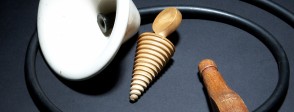Before they encounter the force-feeding equipment, it would be helpful for students to have some contextual knowledge about the suffragette campaign, the imprisonment of suffragettes for militant action and the decision of some suffragettes to use hunger strike as a form of protest. To focus students on the issue of hunger strikes you could begin by asking them to think about the possible responses of the prison authorities when faced with hunger-striking suffragettes. Ask students to suggest why the prison authorities might have been anxious to avoid a suffragette dying in custody and what methods the authorities could have used to feed a suffragette against her will.
Use the whiteboard to show students the image of the force-feeding equipment in For the classroom. Ask them to speculate, in pairs, about three issues: 1) how, exactly, this equipment might have been used; 2) how many people it might have taken force-feed a suffragette using this equipment; 3) how a suffragette might have tried to resist being force-fed by this equipment.
You could then use some of the resources in For the classroom to develop an understanding of the horror of force-feeding. Explain to students that this particular force-feeding equipment was use in Walton Gaol, Liverpool, and that we can find out exactly how it was used because a suffragette who was imprisoned at Walton wrote an account of her experiences in 1914. It would be worth telling students the story of Constance Lytton’s aristocratic upbringing and her experiences as a suffragette and her imprisonment at Walton Gaol. Students can then read Lytton’s powerful account of her force-feeding. Ask them to consider what made this such a traumatic experience for Constance, and for the other suffragettes who were force-fed.
You can find two reconstructions of force-feeding in For the classroom: an artist’s impression of a suffragette being force-fed and a short clip from a documentary film about the suffragettes. Ask the students to analyse these interpretations. How far do they differ? How exactly did the artist and the film-maker capture the horror of force-feeding? Why do students think the artist and the film-maker chose to interpret force-feeding in these ways?
The suffragettes used a wide variety of methods of protest: posters, rallies, songs, letter bombs, acts of civil disobedience and defacing coinage. Look at the defaced coin in For the classroom and use the information in the radio programme to help the students understand why it was a clever way of protesting. Consider examples of several different kinds of suffragette protest and discuss the limits of what students think are acceptable ways of achieving political ends.
The force-feeding equipment could be incorporated into enquiries focusing on very different aspects of history:
Why did it take women in Britain so long to get the vote?
This enquiry can be taught as an unfolding narrative beginning with an examination of women’s lives in 1890 and ending with the representation of the People Act in 1918. Between these start and end points, students can learn about Millicent Fawcett and campaigns of the National Union of Women’s Suffrage Societies after 1897, Emmeline Pankhurst and the foundation of the Women’s Social and Political Union in 1903, the nature of the campaigns for female suffrage to 1909, the increasing militancy of the suffragettes and the impact of World War I on the campaigns for female suffrage. As they engage with the narrative, students can consider the significance of various factors as inhibitors of change: the response from politicians, the attitudes of some men, the attitudes of some women, the nature of the suffragist and suffragette campaigns, the role of the media. At the end of the enquiry students can write an analytical narrative in response to the enquiry question.
When and where was it best to be a woman?
In this enquiry students begin by examining the position of women in early twentieth century Britain and then compare this with the status of women in other cultures at different times in history. In order to focus students on the position of women in Edwardian Britain, the enquiry could begin with the story behind the suffragette defaced penny and the force-feeding equipment in For the classroom. The images in A bigger picture could be used as starting points for research into the status of women in other cultures. It would be worth pointing out that much of the surviving visual evidence relates to elite women. Challenge students to find out about the lives of ordinary women. Students could work in groups to research different cultures and could make presentations to the class, leading to an open discussion in response to the enquiry question.
What do individual stories reveal about conscientious objectors during World War I?
This enquiry could be part of a bigger study of the experience of individuals during the First World War. Students could research the background to conscientious objection and then work individually, in pairs or in small groups to research and present an account of the experiences of a particular conscientious objector. Ask students to focus on: 1) the person’s background and beliefs, 2) the reasons for his decision not to fight in the war, 3) the ways he was treated. At the end of the enquiry, students could reflect on what the individual stories reveal about the general experiences of conscientious objectors and the particular experiences of different individuals.


